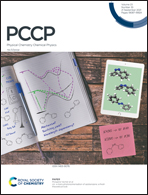The n-type and p-type conductivity mechanisms of the bulk BiOCl photocatalyst from hybrid density functional theory calculations
Abstract
In this work, the n-type and p-type conductivity mechanisms of bulk BiOCl are systematically investigated using first-principles calculations. Under the O-rich growth conditions, BiOCl presents the intrinsic p-type conductivity, which primarily originates from the contributions of the antisite defects OCl. This is in excellent agreement with the observed p-type conductivity in BiOCl under high oxygen partial pressure or in oxygen-saturated solutions in experiments. While BiOCl displays the intrinsic n-type conductivity under the Bi-rich growth conditions, the vacancy defects VCl are responsible for the character. Nevertheless, the extrinsic means or effects could lead to the production and ionization of the O vacancies, which could contribute to the n-type conductivity in BiOCl. Therefore, the intrinsic n-type conductivity behavior reported in BiOCl in recent experiments is well explained. Under the Cl-rich growth conditions, the major donor defects VCl and the major acceptor defects VBi in BiOCl compensate each other, leading to an intrinsic insulator. However, it is shown that the usual unintentional H impurities HBi could form the p-type conductivity in BiOCl under Cl-rich growth conditions and enhance the p-type conductivity under O-rich growth conditions. This helps to understand the p-type conductivity behavior reported or mentioned in BiOCl in many experiments. At the same time, we found that Group II elements Ca and Sr are superior p-type doping elements for BiOCl under the Cl-rich and O-rich growth conditions. The defect physics in the bulk BiOCl photocatalyst is well understood. This work may inspire more magnificent studies on developing BiOCl-based photocatalysts.



 Please wait while we load your content...
Please wait while we load your content...